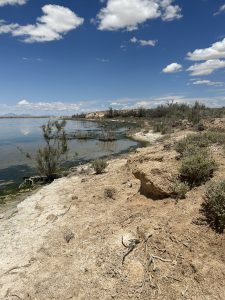PFAS in Vertebrate Animals at Desert Oasis
 DBS&A Biologist and National Environmental Policy Act (NEPA) team leader Jean-Luc E. Cartron, PhD, is among the 15 coauthors of a new article, “Extraordinary levels of per- and polyfluoroalkyl substances (PFAS) in vertebrate animals at a New Mexico desert oasis: Multiple pathways for wildlife and human exposure”, published in the journal Environmental Research.
DBS&A Biologist and National Environmental Policy Act (NEPA) team leader Jean-Luc E. Cartron, PhD, is among the 15 coauthors of a new article, “Extraordinary levels of per- and polyfluoroalkyl substances (PFAS) in vertebrate animals at a New Mexico desert oasis: Multiple pathways for wildlife and human exposure”, published in the journal Environmental Research.
On behalf of the New Mexico Environment Department (NMED), DBS&A has been investigating PFAS groundwater contamination in the vicinity of Holloman Air Force Base in southern New Mexico. DBS&A collaborated with the University of New Mexico’s (UNM) Museum of Southwestern Biology to investigate PFAS contamination of the local wildlife, along with potential impacts on human health.
The study involved more than 2,000 assays to measure tissue-concentrations of 17 PFAS in 23 species of mammals and migratory birds at Holloman Lake, a large, artificial wetland with important concentrations of waterfowl and other animal species. The authors report that “the birds and rodents at Holloman AFB have PFAS tissue concentrations far higher than those measured in nearly all previous surveys of wildlife, with liver concentrations of PFOS and PFAS, respectively, averaging in the 10,000s of ng/g”. Multiple exposure pathways are implicated likely or potentially including ingestion of contaminated soil, water, and aquatic invertebrates, as well as dust inhalation. Special concerns exist regarding hunting at Holloman Lake. As the authors emphasize in their article, contamination levels documented at Holloman Lake are such that “it would never be safe to eat more than 1 gram of game meat per day from Holloman Lake”.
Published by Elsevier, Environmental Research is a multi-disciplinary journal publishing high quality and novel information about anthropogenic issues of global relevance and applicability in a wide range of environmental disciplines, and demonstrating environmental application in the real-world context.
Learn more about the project here. Read more about the study in the news:
Contributors
Christopher C. Witt a,b,* , Chauncey R. Gadek a,b,c , Jean-Luc E. Cartron a,b,d , Michael J. Andersen a,b , Mariel L. Campbell a,b , Marialejandra Castro-Farías a,b , Ethan F. Gyllenhaal a,b , Andrew B. Johnson a,b , Jason L. Malaney a,e , Kyana N. Montoya a,b , Andrew Patterson f , Nicholas T. Vinciguerra a,b , Jessie L. Williamson a,b,g , Joseph A. Cook a,b , Jonathan L. Dunnum a,b
a Museum of Southwestern Biology, University of New Mexico, Albuquerque, NM, 87131, USA b Department of Biology, University of New Mexico, Albuquerque, NM, 87131, USA
c Environmental Stewardship, Los Alamos National Laboratory, Los Alamos, NM, 87545, USA
d Daniel B. Stephens & Associates, Inc., 6020 Academy Road NE, Suite 100, Albuquerque, NM, 87109, USA
e New Mexico Museum of Natural History and Science, Albuquerque, NM, 87104, USA
f Eurofins Environment Testing America, West Sacramento, CA, 95605, USA
g Cornell Lab of Ornithology, Cornell University, Ithaca, NY, 14850, USA
